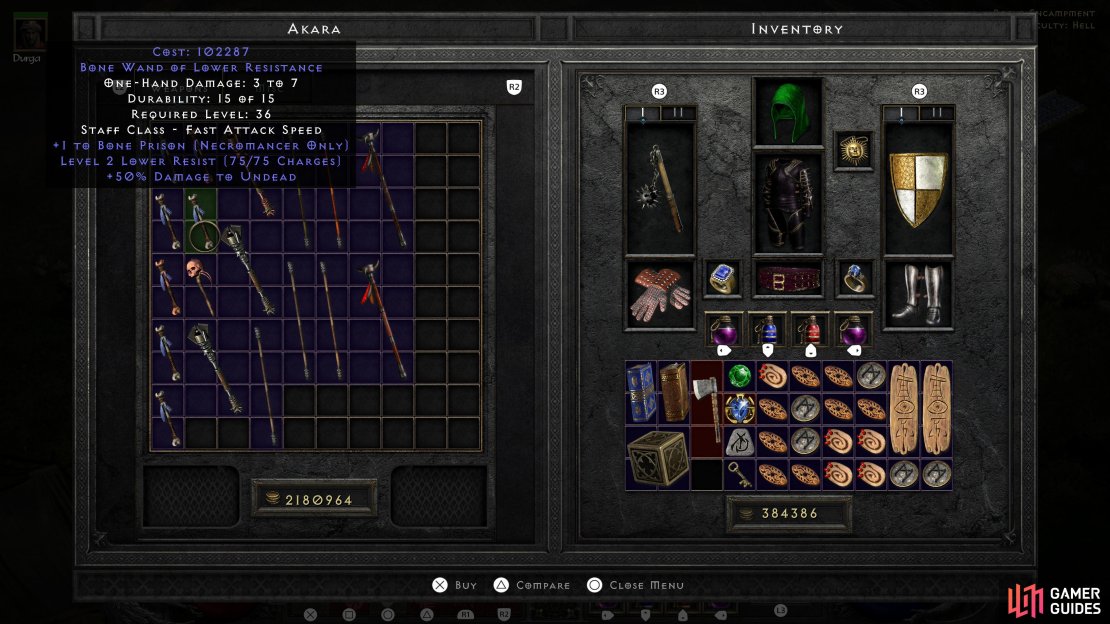This page will cover enemy immunities, and how to overcome them.
Monster Immunities¶
As your own resistances are penalized in Nightmare and Hell difficulty, enemy resistances are boosted. This is not a significant factor in Nightmare (or Normal, for that matter), although a few single-element immune monsters may appear. In Hell difficulty, however, nearly every monster you’ll encounter will have at least one immunity, which is typically universal to that creature’s type. Burning Souls will regularly be immune to lightning, Fallen will be immune to fire, Oblivion Knights will be immune to cold, and so on.
Unique monsters, in addition possessing appropriate immunities due to their base creature type, have three random modifiers, which can also affect their resistances in various ways:
| Unique Modifier | Resistances |
|---|---|
| Cold Enchanted | Cold Resistance +75% |
| Fire Enchanted | Fire Resistance +75% |
| Lightning Enchanted | Lightning Resistance +75% |
| Magic Resistant | Cold, Fire, Lightning Resistance +40% |
| Spectral Hit | Cold, Fire, Lightning Resistance +20% |
| Stone Skin | Physical Resistance +50% |
A monster with immunity to an element functionally just has 100% (or higher) resistance to it.
If the boons from these modifiers raise their resistance to 100%+, they’ll gain an immunity, so a “Cold Enchanted” Unique Fallen could very well end up fire immune (base) and cold immune.
Boss monsters rarely have immunities, and monsters of any sort do not tend to spawn with more than two immunities.
Dealing with Monster Immunities - Avoidance¶
Certain builds - namely ones whose damage is one of the four primary elements (fire, cold, lightning or poison) - can be significantly impeded by immunities. A Blizzard Sorceress, for example, is all but useless when facing cold immunes. [Mercenaries] can help, but it takes an awfully well-equipped mercenary to single-handedly put down some Unique monsters and their minions, and even then, this drops the kill rate to the point where you’d probably be better off fighting something else.
Other classes - ones that deal physical or magical damage, or builds with two effective means of dishing out damage (like the [Poison Necromancer] or the Meteorb Sorceress) - will find themselves less hindered, less often, but dual-immunes do exist, and while they’re uncommon, they’re not terribly rare.
So what are our options?
First things first, you can always quit the game and load a new one. Many areas have more possible enemies than will spawn at any given game - typically only three of however many possible types of enemies will spawn. If there’s just one problem enemy and you can return to the area easily, this is a possible solution.
Sometimes, however, there are enough different types of immune enemies to preclude this possibility, or perhaps you can’t easily return there. In which case there’s another, equally unsavory option - simply avoiding the enemies in question.
Dealing with Monster Immunities - Breaking Immunity¶
Neither of these are terribly elegant solutions, but sometimes discretion is the better part of valor.
Other than avoiding immune foes, your options are limited to the Necromancer curses Amplify Damage and Lower Resist and the Paladin aura Conviction. Modifiers on certain unique items that reduce an enemy’s resistance to a specific type of damage (for example the “-40 - -50% to Enemy Poison Resistance” on Death’s Web) and resistance-lowering skills like the Sorceress’s Cold Mastery will not break immunity. These properties will, in fact, lower an enemy’s resistance by the stated amount, and in some cases are better than pure damage, but a creature who is immune will remain immune. As for the aforementioned curses and aura:
- Amplify Damage: Reduces target’s physical resistance by 100%.
- Lower Resist: Reduces target’s resistances to fire, cold, lighting and poison 31 - 62%+ (depending on sLv).
- Conviction: Reduces the fire, cold and lightning resistances of all nearby creatures by 30 - 125%+ (depending on sLv).
As you can see, there’s not much that can be done about magic immunes, but those are mostly limited to greater mummies. There’s not much option for the Hammerdin save to just make do with whatever damage their weapon can deal directly. Fortunately for the Hammerdin, magic immunity is perhaps the rarest immunity in the game.
For breaking physical resistance, Amplify Damage is the way to go. Lower Resist - another Necromancer curse - can drastically lower every other resistance, and is especially useful for [Poison Necromancers]. Conviction lowers resistances further, but does require some proximity (its range is 13.3 yards, no matter its sLv) and doesn’t affect poison resistance… which is fair enough, for a Paladin. There are two complications when it comes to breaking resistances, one of which should be fairly obvious - not everybody will be playing a Necromancer or Paladin - and on which is more obscure.
First, the obscure issue. When a creature is immune to a form of damage (its resistance to said damage is 100% or higher), it gains a hidden, added boon - effects that lower resistances are only 20% effective when applied to immunities. If a creature with 120% resistance to fire suffered the effects of an sLv1 Conviction aura (-30% resistances), their fire resistance would not drop to 90% (hence breaking the immunity), but rather it would drop to 114% - still fire immune. This penalty persists even after a creature’s immunity is broken - the same monster in the example above, if affected by an sLv19 Conviction aura (-120% resistances), wouldn’t drop to 0 fire resistance, it would instead drop to 96% - no longer immune, but still highly resistant to fire.
What’s the point of breaking a monster’s immunity if they’re still going to be 90%+ resistant to the element they were previously immune to? Well, there’s some good news. While Amplify Damage/Lower Resist/Conviction only work at 20% effectiveness, other forms of resistance lowering will work at full potency once the immunity is broken. If a Necromancer uses Lower Resist on a poison immune enemy and breaks their poison immunity, their aforementioned Death’s Web will grant the full -40 - -50% penalty to enemy poison resistance… which is a big deal for a [Poison Necromancer] whose high level Poison Nova can be dealing 6,000+ damage a cast. Even half of that is decent. The same goes for a [Lightning Sorceress] or Javazon wearing [Griffon’s Eye], which explains why such items are highly prized. Alas for the Blizzard Sorceress, enemies that are cold immune tend to have very high cold resistances, meaning it’ll take a lot of work to break most cold immunities… which makes sense, considering an sLv30 Cold Mastery would reduce an enemy’s cold resistance by -165%, trivializing any foe not immune to cold damage.
If you’re not playing a Necromancer or Paladin, good news! You have options. There are a variety of items that inflict Lower Resist or Amplify Damage when used, but most of these are items that are… very niche. That being the case, we’ll list the two best options for breaking resistances.
(1 of 4) Lower Resistance gear is expensive to buy,
Lower Resistance Wands¶
The easiest option by far is to simply buy a weapon with the “of Lower Resistance” property, which will give it charges of Lower Resist. Any class can use it, and you can simply peruse Akara’s wares until she has one in stock. Keep in mind, Lower Resist is a Lv30 skill, so you probably shouldn’t bother shopping for one until you’re in later difficulties. Which is just as well, as immunities don’t become commonplace until Hell difficulty, making it a common rite of passage to shop for a Lower Resist item (typically a wand) as soon as you make it to Hell difficulty.
This has some downsides, however. First, buying the wand itself can be expensive, depending on any accompanying +skills. Expect to spend tens of hundreds of thousands of gold doing this, which, to be fair, shouldn’t be too great a burden at this point in the game. Worse, however, are the recharge costs; recharging is incredibly expensive - think in the order of thousands of gold per charge. Second, the sLv of the Lower Resist skill will certainly be quite low, as the “of Lower Resistance” modifier will only give you sLv1 - 3. Third, you’ll want to keep this item equipped in your alternate weapon slot, meaning you won’t be able to use something else like… say… Call to Arms.
Infinity Runeword¶
A far more expensive option is to create an [Infinity] polearm. This requires any four-socket polearm to serve as a base (not spears!) and the runes Ber + Mal + Ber + Ist. Since Ber is one of the most valuable runes (and hence, items) in the game, and this runeword requires two of them, it’s out of reach for all but the wealthiest players. Still, if you get the resources you’ll get a wonderful weapon, which is typically assigned to a character’s Act 2 [Mercenary].
While [Infinity] has numerous useful modifiers, the one of interest when it comes to breaking immunities is its sLv12 Conviction aura. This will turn your mercenary into a walking debuffing machine, inflicting -85% resistances to all foes within 13.3 yards - very, very handy for almost any elemental build, and capable of breaking some resistances… as long as their base resistance isn’t above 116%, anyways.
Sundered Charms¶
One of the most consequential changes added to Diablo 2 Resurrected were [Sundered Charms]. These can be dropped by Champion, Unique, Superunique and Boss monsters in [Terror Zones] and have an item level (iLv) of 75, meaning they can only drop in Hell Difficulty. These unique Grand Charms will break a single type of immunity when kept in a player’s inventory, reducing the resistance of previously immune monsters to 95%. As a downside, they’ll make the player more vulnerable to that form of damage. The six different types of Sundered Charms are as follows:
- The Black Cleft: Sunders Magic Immunity, player’s Magic Resistance is lowered by 45% to 65%.
- The Bone Break: Sunders Physical Immunity, player takes 10% to 30% extra Physical Damage.
- The Cold Rupture: Sunders Cold Immunity, player’s Cold Resistance is lowered by 70% to 90%.
- The Crack of the Heavens: Sunders Lightning Immunity, player’s Lightning Resistance is lowered by 70% to 90%.
- The Rotting Fissure: Sunders Poison Immunity, player’s Poison Resistance is lowered by 70% to 90%.
- Flame Rift: Sunders Fire Immunity, player’s Fire Resistance is lowered by 70% to 90%.
An enemy that’s 95% resistant to a form of damage still isn’t ideal, but it’s a good starting point, and a damn sight easier to obtain than [Infinity] and provided you can boost your resistances up to compensate for the vulnerability Sundered Charms impose, it’s less fuss than a Wand of Lower Resistance. For more information, check out the page [How to Farm Sundered Charms].





No Comments